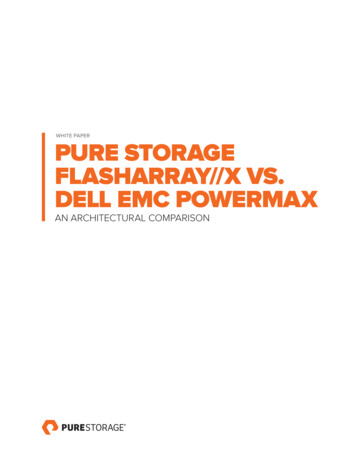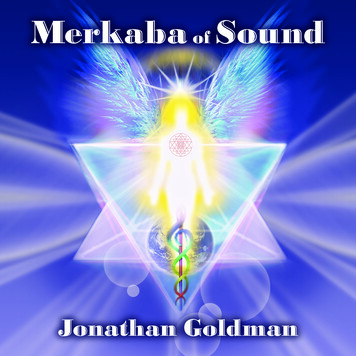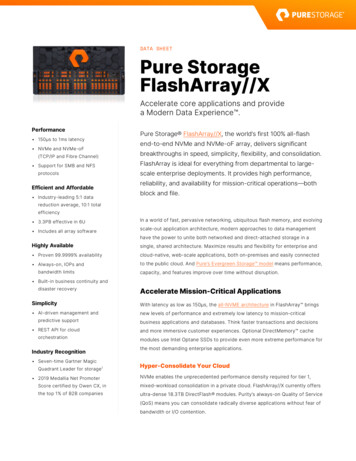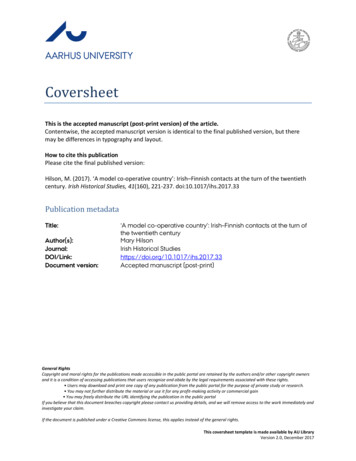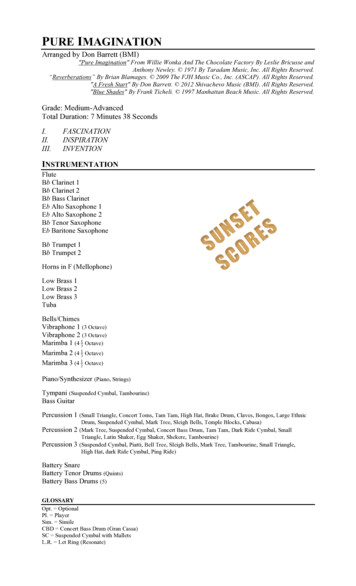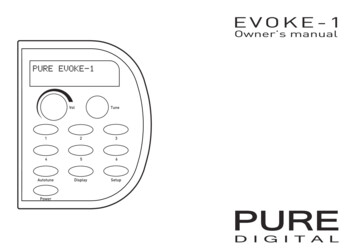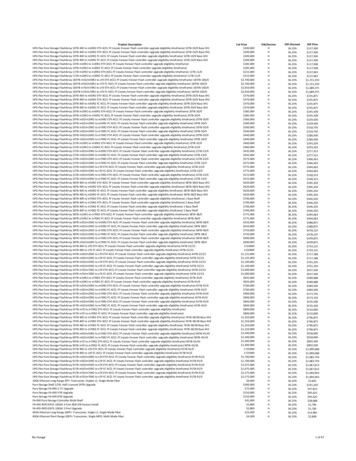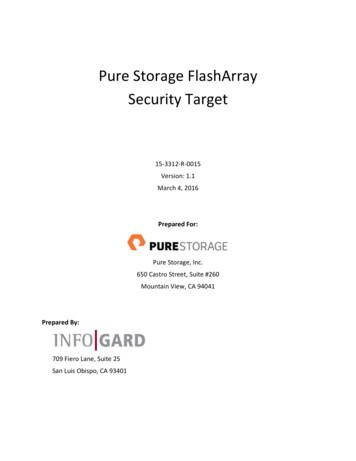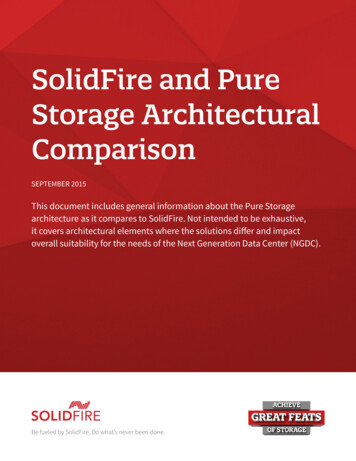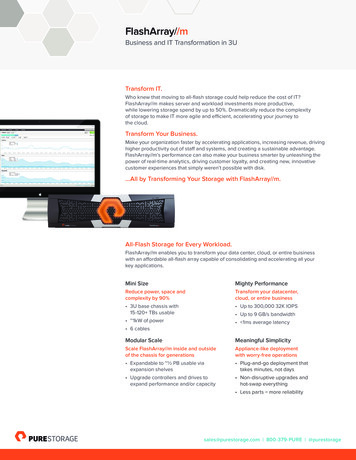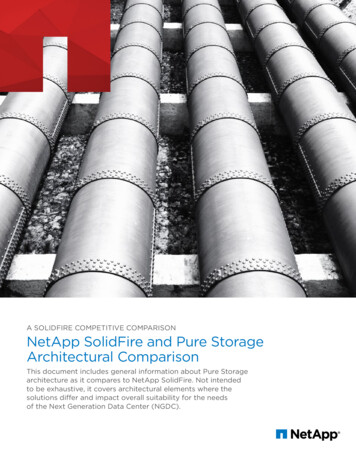
Transcription
Extracted from:Programming Sound with Pure DataMake Your Apps Come Alive with Dynamic AudioThis PDF file contains pages extracted from Programming Sound with Pure Data,published by the Pragmatic Bookshelf. For more information or to purchase apaperback or PDF copy, please visit http://www.pragprog.com.Note: This extract contains some colored text (particularly in code listing). Thisis available only in online versions of the books. The printed versions are blackand white. Pagination might vary between the online and printed versions; thecontent is otherwise identical.Copyright 2014 The Pragmatic Programmers, LLC.All rights reserved.No part of this publication may be reproduced, stored in a retrieval system, or transmitted,in any form, or by any means, electronic, mechanical, photocopying, recording, or otherwise,without the prior consent of the publisher.The Pragmatic BookshelfDallas, Texas Raleigh, North Carolina
Programming Sound with Pure DataMake Your Apps Come Alive with Dynamic AudioTony HillersonThe Pragmatic BookshelfDallas, Texas Raleigh, North Carolina
Many of the designations used by manufacturers and sellers to distinguish their productsare claimed as trademarks. Where those designations appear in this book, and The PragmaticProgrammers, LLC was aware of a trademark claim, the designations have been printed ininitial capital letters or in all capitals. The Pragmatic Starter Kit, The Pragmatic Programmer,Pragmatic Programming, Pragmatic Bookshelf, PragProg and the linking g device are trademarks of The Pragmatic Programmers, LLC.Every precaution was taken in the preparation of this book. However, the publisher assumesno responsibility for errors or omissions, or for damages that may result from the use ofinformation (including program listings) contained herein.Our Pragmatic courses, workshops, and other products can help you and your team createbetter software and have more fun. For more information, as well as the latest Pragmatictitles, please visit us at http://pragprog.com.The team that produced this book includes:Jacquelyn Carter (editor)Potomac Indexing, LLC (indexer)Candace Cunningham (copyeditor)David J Kelly (typesetter)Janet Furlow (producer)Juliet Benda (rights)Ellie Callahan (support)Copyright 2014 The Pragmatic Programmers, LLC.All rights reserved.No part of this publication may be reproduced, stored in a retrieval system, ortransmitted, in any form, or by any means, electronic, mechanical, photocopying,recording, or otherwise, without the prior consent of the publisher.Printed in the United States of America.ISBN-13: 978-1-93778-566-6Encoded using the finest acid-free high-entropy binary digits.Book version: P1.0—January, 2014
PrefaceI love sound. That may seem a little strange; a lot of people would say theylove music, but I love sound—including music. I group them together, and Ifind that the line between them is blurry. There are interesting rhythmic andeven melodic and harmonic elements in everyday sounds, if you listen forthem. On the other hand, elements of music when taken out of context canlose their musicality and sound like natural events.I hear little things all the time, which can be either good or bad. If something’srattling in the car it drives me crazy and I have to stop the car and make thenoise stop. That makes my wife crazy, but I can’t help myself. That’s why it’sso important to me to have sound done well in digital experiences, where Ispend most of my time. When I say “digital experiences” I mean anythinghappening on a computer: web pages, web applications, native applications,mobile apps, kiosk apps, art installations, and, of course, games in any form.Sound, and now I mean sound effects as distinct from music, is tricky to getright in digital experiences. Sound is very rarely a necessity. Even in games,where it’s expected as a part of the experience, it’s rare that the user needssound to play. There are usually controls somewhere to turn sound off, butyou’ll never find a control to turn off the screen or mouse or touch interaction.On the other hand, playing a game without sound takes away an importantdimension of the experience. It’s flat, boring, unconvincing. If there’s not alittle ding when you collect a coin, it’s not satisfying. If you’re running throughthe forest and you don’t hear forest sounds, it’s the opposite of immersive—itfeels like merely looking at someone running through the forest on a littlescreen instead of being there.Not only games can benefit from sound in this way, though. A few apps I’veused struck the right tone, if you’ll pardon the pun, with some tasteful and,above all, meaningful sounds as part of the experience.This book is not able to teach you good taste, sadly. But, if you decide thisbook is for you, you will learn how to gain understanding and control over Click HERE to purchase this book now. discuss
Preface vithe sound you decide fits the digital experiences you create. You’ll learn howto design and create the sound you want to hear.Who Is This Book For?I make a few assumptions about you, the reader. First of all, I assume you’reas interested in the audible experience as I am. You may be a programmeror designer. You’re probably interested in what you can learn about thetechnical details of getting sounds into a web or native app, but it’s OK ifyou’re just interested in learning about some technical approaches todesigning sound.I assume you’ve dabbled with sound design in the past. It was most likely bydigging around in a sample library for the right premade sound and maybeediting that sound a bit to get what you wanted out of it. Maybe you’reintrigued by the idea of doing some professional sound design in the gameor movie industry, or maybe not, but for now you want to know how to gainmore control over your ability to enhance digital experiences both native andon the Web.You may also be a musician. As I mentioned, this book isn’t about music indigital experiences; it’s geared toward sound effects. However, all of the skillsyou’ll learn here are easily applicable to musical experiences and musicalapps, and at the very least they’ll give you a better understanding of how tothink about sound in music.In short, I assume you have little to no experience with anything but dabblingwith sound, but you’re interested and want to learn more. I would beextremely happy if this book helps out those independent or small-shopdevelopers and designers who have to wear many hats during the day anddon’t have the budget for a dedicated sound team.What This Book CoversThis is a practical book for people interested in digital sound design for theWeb and native apps. We’ll focus on using one software application, PureData. We’ll go through the steps of creating two sets of practical examples:sound-effect scenes that can be controlled dynamically or output to a file.The first set will illustrate a few different sound-synthesis methods, and thesecond will show how to work with existing sounds, like you might get froma professional sound-effect library. Click HERE to purchase this book now. discuss
What This Book Doesn’t Cover viiAfter getting used to using Pure Data and creating these examples, we’ll lookbriefly at how to get the sounds we’ve made out of Pure Data and into a usableformat, and then quickly discuss some sound-production topics.We’ll then take a brief interlude to discuss the user experience (UX) of soundon the Web and in native applications.Finally, we’ll consider two premade projects, a web project and a nativeapplication. We’ll design sound effects for both of these, taking into accountwhat the best UX for each is and what you’ve learned of sound design, andconsider the possibilities of dynamic sound in the native applications.We’ll wrap up by considering what you’ve learned so far and a few possibledirections you could take next in your journey to becoming a sound designer.What This Book Doesn’t CoverSound design is a deep and rich field. It grew up with the movie industry andis an essential part of the game industry. There are also many differentapproaches to designing sound within those areas. This book is an introduction to sound design for digital experiences on the Web and in nativeapplications, which could include games.We’ve chosen a pragmatic approach to introducing this subject; one thatfocuses on building practical examples using synthesis with a proceduralsound application, which is only one of many possible ways to design sound.Here are some other important topics that aren’t in scope for this book, butyou may want to dig into next: This book does not cover capturing or recording sounds for analysis orsound production. Audio engineering, field recording, and Foley studiowork are all good things to have under your belt as a sound designer, butwe won’t discuss them in any depth here. Analysis of recorded sound is also beyond the scope of this book. Toreproduce a convincing effect it’s very useful to know what’s going on ina real-world example instead of guessing. We’ll only have space to do avery rudimentary, intuitive analysis of some sounds as we build ourexamples, but as an area for later study, sound analysis would be verybeneficial. There is a lot of math behind describing and reproducing sound. Algebra.Trigonometry for describing oscillators and geometric waves. Calculusfor, among other things, Fourier analysis. That math is good to know, butbeyond the scope of this book. Click HERE to purchase this book now. discuss
Preface viii A deep understanding of the science of sound is extremely helpful to thesound designer. In the field of physics, material physics, fluid dynamics,acoustics, and many others will help you understand from first principleshow sound is made and how to reproduce it. Understanding the mathused to express the physics in these areas will be helpful too. All of ourpractical examples will be intuitively designed, and we won’t take the timeto dig into the science of why the sound works the way it does. A greatnext step would be to start to understand the underlying causes of sound. Psychoacoustics, or the study of how humans process and perceive sound,is important to understand as a sound designer. There are some surprisingthings to learn from the field that can help you become a better and moreefficient sound designer, but we won’t have time to dig into those here.Where Will You Be When You Finish This Book?When you’ve read this book you’ll have had the experience of creating a setof sound effects using Pure Data, ready for inclusion in a dynamic soundapplication or for creating a static sound file. You’ll have a practical understanding of sound-synthesis techniques and a general understanding of howdifferent fundamental components of sound can be used to produce soundsanywhere, from those we hear every day to those we’d hear only in a futuristicscience-fiction world.You’ll be ready to take the next steps to understanding and growing as asound designer, whether that be practicing what you learn here, buildingsounds for games and apps you’ll be making, or digging in deeper to the math,physics, and other fundamentals of sound design.Online ResourcesOn The Pragmatic Bookshelf’s page for this book there are some importantresources.1 There are code downloads containing all the Pure Data patchesyou’ll see in this book, as well as the source for the web, Android, and iOSprojects. You’ll also find feedback tools such as a community forum and anerrata-submission form where you can recommend changes for futurereleases of the g-sound-with-pure-data Click HERE to purchase this book now. discuss
Sound design is a deep and rich field. It grew up with the movie industry and is an essential part of the game industry. There are also many different approaches to designing sound within those areas. This book is an introduc-tion to sound design for digital experiences on the W
